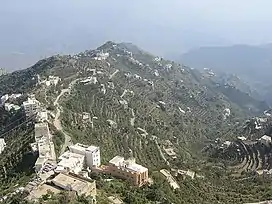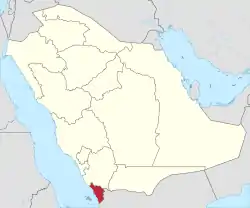Jazan Province
Jizan Region also spelled Jazan (Arabic: جيزان, romanized: Jizan) is the second smallest (after Al Bahah) region of Saudi Arabia. It stretches 300 km (190 mi) along the southern Red Sea coast, just north of Yemen. It covers an area of 11,671 km2 and had a population of 1,404,997 at the 2022 census.[1] The region has the highest population density in the Kingdom. The capital is the city of Jazan; Prince Muhammad bin Nasser has been the Governor since April 2001.[2]
Jizan
جيزان | |
|---|---|
 The Fifa Mountains | |
 Map of Saudi Arabia with Jizan highlighted | |
| Country | |
| Capital | Jazan |
| Boroughs | 14 |
| Government | |
| • Governor | Prince Muhammad bin Nasser |
| • Deputy Governor | Muhammad bin Abdulaziz bin Muhammad Al Saud |
| Area | |
| • Total | 11,671 km2 (4,506 sq mi) |
| Population (2022 Census) | |
| • Total | 1,404,997 |
| • Density | 120/km2 (310/sq mi) |
| ISO 3166-2 | 09 |
The region includes over 100 islands in the Red Sea. Jazan Economic City is a mega project that is planned to boost the economy of the region and make it part of the Saudi economic growth.[3] The Farasan Islands, Saudi Arabia's first conservation protected area, is home to migratory birds from Europe in winter.
Geography
The region divides into three parts.
- The Al-Sarawat mountains inland, which rise to about 3,000 metres.
- The Alhazoun forest district consists of forest broken by some areas of rich pasture.
- The plains are noted for the production of coffee beans, cereal grain crops (barley, millet and wheat) and fruit (apples, bananas, grapes, mangoes, papayas, plums and citrus varieties).
Though the climate on the highlands is similar to the relatively wetter climate of 'Asir, the coastal regions of Jizan province are part of Tihamah, probably the hottest place in the country, with mean maximum temperatures ranging from 40 °C (104 °F) in July to 31 °C (88 °F) in January. High humidity from coastal lagoons makes the climate even less bearable than it would be otherwise. Rainfall is extremely low at less than 75 millimetres (3 inches) per year. Sabya is located in the center between the mountain and the beach.
Population
| Year | Pop. | ±% p.a. |
|---|---|---|
| 1992 | 865,961 | — |
| 2004 | 1,187,587 | +2.67% |
| 2010 | 1,374,845 | +2.47% |
| 2018 | 1,603,659 | +1.94% |
| source:[4] | ||
Sub-divisions
The region is now sub-divided into 17 governorates (following the creation of the governorates of At-Tuwal from part of Samtah, Fayfa from part of Jizan, and Harub from part of Al-Aydabi) as follows:[5][6]
| Name | Native name | Census 15 Sept 2004 |
Census 28 Apr 2010 |
Census 10 May 2022 | |
|---|---|---|---|---|---|
| Abu Arish | أبو عريش | 123,943 | 196,462 | 187,060 | |
| Ad-Dayir | الدائر | 49,239 | 58,325 | 47,424 | |
| Ad-Darb | الدرب | 52,062 | 70,740 | 68,965 | |
| Ahad Al-Masarihah | أحد المسارحة | 70,038 | 109,866 | 130,545 | |
| Al-Ardah | العارضة | 62,841 | 76,033 | 79,730 | |
| Al-Aydabi | العيدابي | 52,515 | 61,043 | 32,940 | |
| Al-Harth | الحرث | 47,073 | 23,496 | 11,561 | |
| Al-Raith | الريث | 13,406 | 19,022 | 16,877 | |
| Bish | بيش | 58,269 | 77,406 | 86,996 | |
| Damad | ضمد | 62,366 | 71,256 | 64,136 | |
| Farasan | فرسان | 13,962 | 18,015 | 13,529 | |
| Jazan | جازان | 255,340 | 163,703 | 200,911 | |
| Sabya | صبياء | 198,086 | 227,519 | 223,083 | |
| Samtah | صامطة | 128,447 | 201,959 | 154,925 | |
| Total Province | 1,187,587 | 1,374,845 | 1,404,997 |
Ethnography
The Arabic language is spoken by over 90% of the inhabitants. Parts of Jizan was claimed to be part of Yemen by many Yemen. It was annexed by Saudi Arabia during the Saudi–Yemeni War (1934) and Imam Yahya suspended Yemen's claim to the region in the treaty of Taif. Though many Yemenis continued to claim Jizan until the issue was settled formally and finally in the Saudi-Yemeni border agreement of 2000.[7]
Environmental projects
In 2019, the Saudi Government allocated $213 million to implement water and environmental projects in the region. Such projects include, installing a sewage treatment line, sewage network, sewage connections for households, and a station for pumping.[8]
Mass shootings of Ethiopian refugees
Since 2014, refugees have been killed after crossing the Saudi border by the Saudi Border Guard. Since 2023, at least several hundred Ethiopian refugees have been killed at the border between Yemen and the provinces Jazan, Asir and Najran. The Saudis also used explosive weapons.[9][10]
References
- "Population Characteristics surveys" (PDF). General Authority for Statistics. 2017.
- "CTHM issues 4 royal decrees". kuna.net.kw. 2001.
- "Jazan Economic City Quarter Report" (PDF). Rcjy.gov.sa. 2017. Archived from the original (PDF) on 15 December 2018. Retrieved 13 December 2018.
- "Saudi Arabia: Regions & Major Cities - Population Statistics, Maps, Charts, Weather and Web Information". www.citypopulation.de.
- "Detailed results of JIZAN (general population and housing census 2010-2010)" (PDF). General Authority for Statistics. 23 February 2016.
- "Population Characteristics surveys 2017" (PDF). General Authority of Statistics.
- Schmitz, Charles; Burrowes, Robert D. (25 October 2017). Historical Dictionary of Yemen. Rowman & Littlefield. p. 269. ISBN 9781538102336.
- "Saudi Arabia implements environmental projects in Jazan worth over $200m". Arab News. 15 April 2019. Retrieved 15 April 2019.
- "Saudi Arabia: Mass Killings of Migrants at Yemen Border". Human Rights Watch. 21 August 2023. Retrieved 21 August 2023.
- Beaumont, Peter (21 August 2023). "'Fired on like rain': Saudi border guards accused of mass killings of Ethiopians". The Guardian. ISSN 0261-3077. Retrieved 21 August 2023.
Further reading
- S.I. Bruk, Narody Peredney Azii (1960).
- S.I. Bruk, and V. S. Apenchenko, Atlas Narodov Mira (Moscow: Academy of Science, 1964).
- A. Gabriel, Religionsgeographie von Persien (Vienna, 1971).
External links
- Official website
- A travel through the province of Jizan, Splendid Arabia: A travel site with photos and routes
.svg.png.webp)